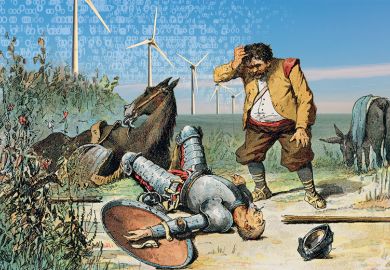In his book Thinking, Fast and Slow, the Nobel prizewinner Daniel Kahneman argues that we think in two key modes – automatic and effortful – or, in other words, fast (non-voluntary) and slow (attentional). It is, of course, the latter that has particular significance for teaching and learning in higher education.
Online teaching can, and maybe should, be formulated to encourage students to engage in slow thinking via online media. This kind of thinking happens when learners are asked to interpret, analyse, write or discuss online content such as academic articles and posts. But what about images?
A body of research and theory supports a decades-long argument about the persuasive, consent-inducing and consciousness-shaping influence that images have in modern digital media. Images also play important roles in science learning.
THE Campus resource: Using visual media to enhance online learning
This calls for serious consideration and analysis of the role of images in higher education thinking. Despite evidence that pictorial images can support “higher-level” thinking at universities, their application is still marginalised.
Recent research into the use of photographs chosen by psychology lecturers in their presentations at 16 UK universities reveals that only a third of these pictures were referred to by lecturers to address lecture content. None was used for analytical purposes.
But an introductory psychology lecture on attachment theory, for example, could easily analyse photographs from Harlow’s classic study of infant monkeys embracing their surrogate “mothers”, which were made from either wire or soft cloth. Such carefully chosen and provocative visuals provide ample opportunities for a “slow picture” talk.
Such a talk can be facilitated through inquiry graphics, which are graphic or visual media such as photographs, videos or illustrations, that are positioned centrally in learning to drive discussions and analysis on studied concepts. An inquiry graphics analysis means going from micro- to macro-level interpretation − in the example of Harlow’s monkeys images, this means naming and describing the details in the images to explore the concept of attachment theory.
Micro interpretation means noticing and naming individual things: What is each thing like? What qualities does it have? For example, “the wire the monkeys are touching must be cold”. Then the question becomes: What is happening? This “activates” a static image. For example, “monkeys are embracing an object made of wire”. We then ask: What do the presence and descriptions of these things mean? For example, “the act of embracing can be interpreted as a wish for closeness and love”.
The macro level exploration would then link these micro details and interpretations to the main concept under discussion: attachment theory. How can learners link the things observed and described to what they have read on attachment theory? How can these descriptions push the learning of the concept further? “The wire is cold, so what does coldness or being cold mean in attachment theory? How about closeness and love?”
Let’s consider another example, the Bayeux Tapestry. That famed 70-metre-long piece of embroidery has been explored by generations of history students as part of studying the conquest of England by William, Duke of Normandy in 1066.
By paying close attention to details in the tapestry, students can develop rich narratives and accounts of that era. An inquiry graphics method could first draw on the vivid visual resources , photographs, videos and graphics of the Bayeux Tapestry available online. These resources will direct students’ attention to the objects and characteristics presented in these visual media in relation to that historical era and related written documents.
A “slow picture” talk facilitated through such an in-depth image analysis and discussion can alert us to the various disputes surrounding the interpretation of the embroidered images − for example, whether it is really King Harold who is depicted as being shot through the eye with an arrow?
With students already using social media during their learning, building on social media picture frenzy for inquiry graphics activities in online teaching shows promise. For example, embedding a relevant Twitter feed in a synchronous lecture and then asking students to choose one picture from the feed for dialogic analysis presents an opportunity for engaged learning that links to the real world and current affairs.
THE Campus resource: Using 360-degree video to bring online classes to life
Applying “effortful” visual thinking in online teaching could even counter the non-stop acceleration of visual technology and media consumption. It also challenges a stereotypical view of images as “just for fun” or “artsy” and therefore unsuitable for “serious learning”. Importing and pausing visual media for conversational analysis provides an antidote to today’s almost unavoidable picture binging through film and other entertainment media.
We’ve now had various slow movements, from “slow food” to “slow fashion”. Let’s add “slow pictures” to the list and finally, truly, let pictures be worth a thousand words.
Nataša Lacković is a scholar of graphics in education, visual learning, semiotics and new literacies at Lancaster University, and the author of Inquiry Graphics in Higher Education: New Approaches to Knowledge, Learning and Methods with Images.
Zoe Hurley is assistant dean for student affairs in the College of Media and Communications at Zayed University, Dubai, United Arab Emirates.
Register to continue
Why register?
- Registration is free and only takes a moment
- Once registered, you can read 3 articles a month
- Sign up for our newsletter
Subscribe
Or subscribe for unlimited access to:
- Unlimited access to news, views, insights & reviews
- Digital editions
- Digital access to THE’s university and college rankings analysis
Already registered or a current subscriber? Login







